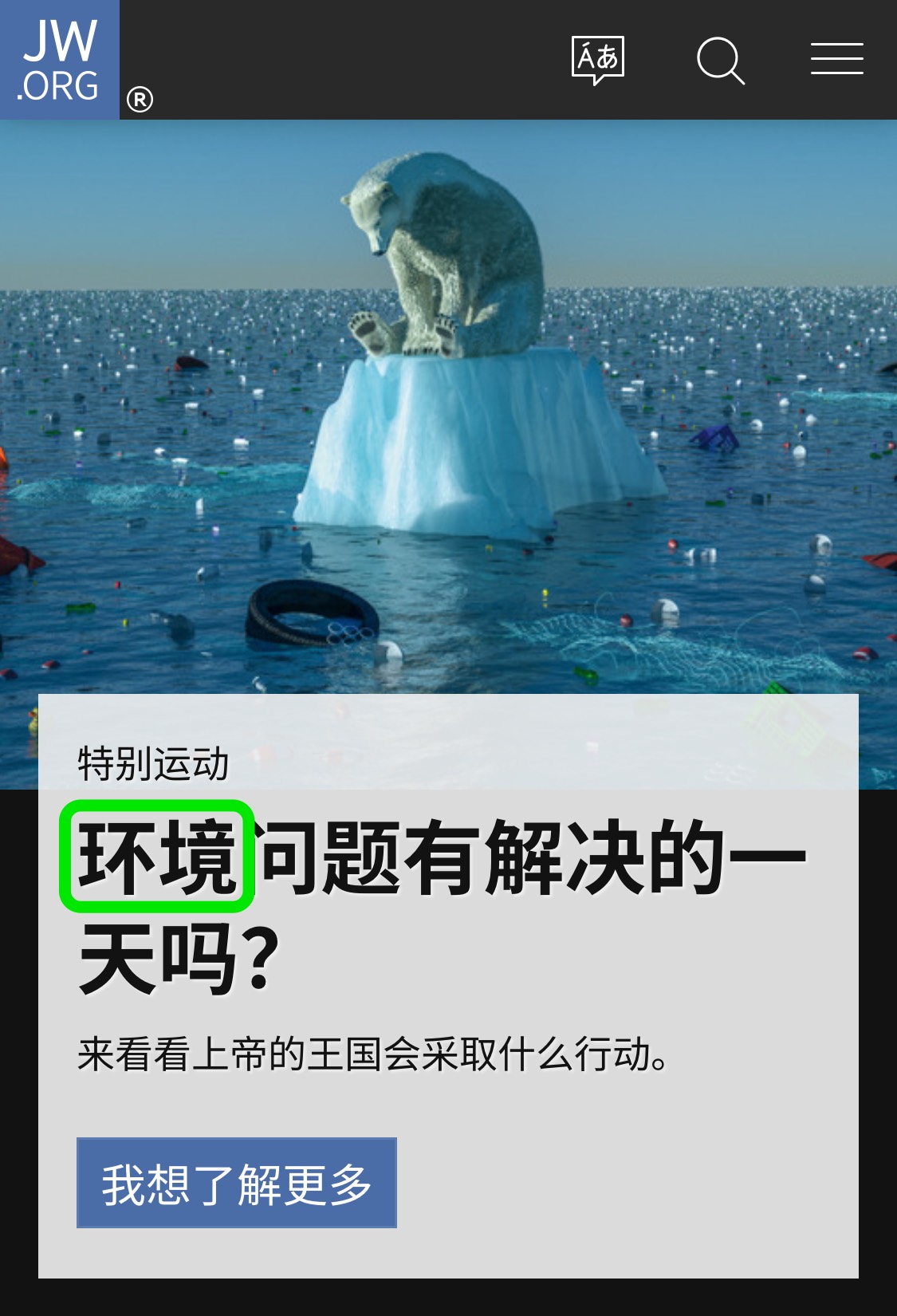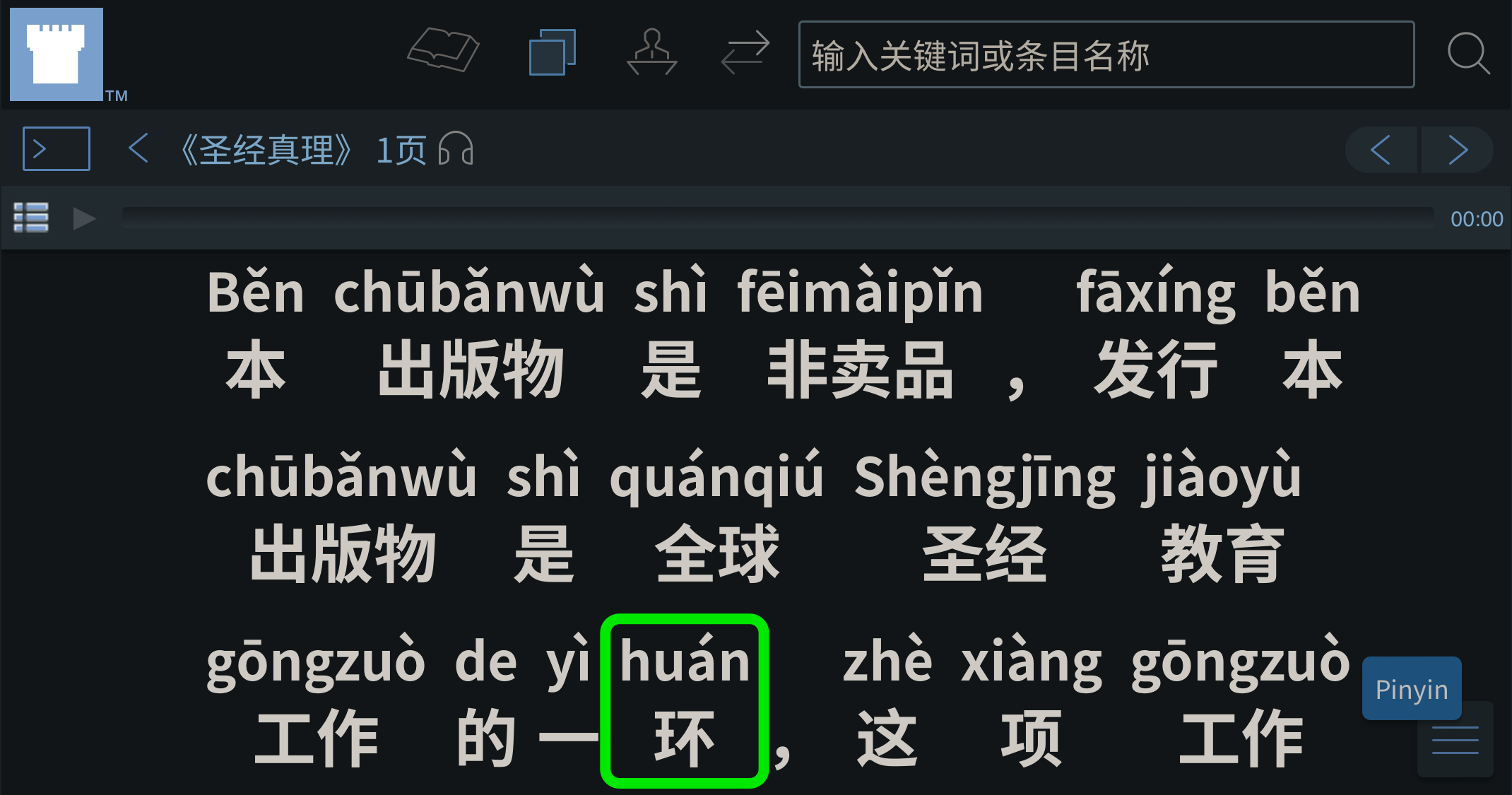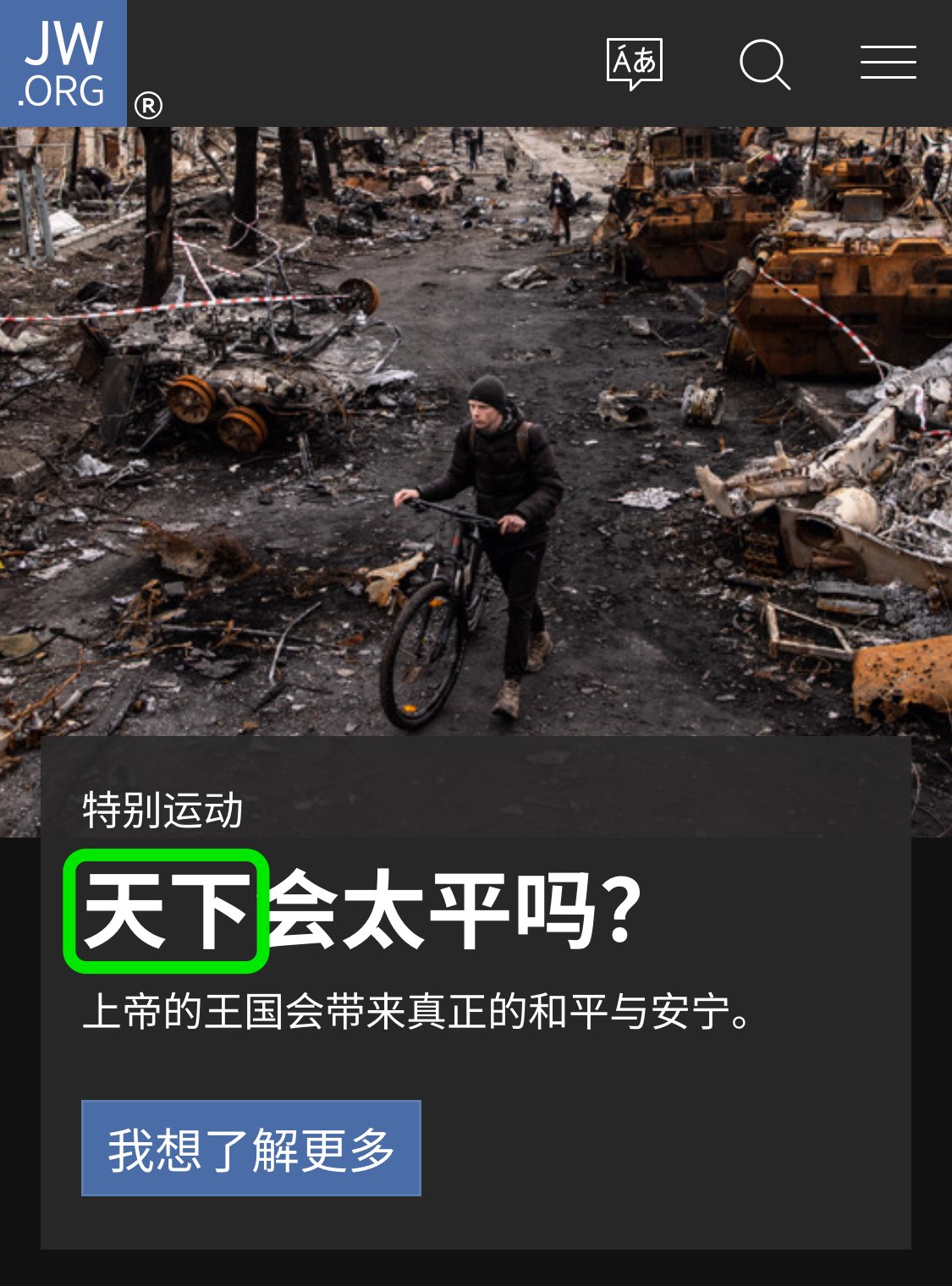huánjìng (huán·jìng surrounding; encircling · {(set of) boundaries → [(bounded) place; area] → [condition; situation; circumstances]} → [environment; surroundings; circumstances; situation; context | environmental] 环境 環境) ← Tap/click to show/hide the “flashcard”
[Notes: Tap/click on a Pīnyīn (Pīn·yīn {Piecing Together of} · Sounds → [Pinyin] 拼音) expression to reveal its “flashcard”; tap/click on a “flashcard” or its Pīnyīn (Pīn·yīn {Piecing Together of} · Sounds → [Pinyin] 拼音) expression to hide the “flashcard”. 📖 📄 📘 icons mean 📖 Reveal All, 📄 Reveal Advanced, and 📘 Reveal None re all the “flashcards” in the heading, paragraph, etc. that they are placed at the beginning of.]
At the time of this writing, the main page of jw.org was featuring the following headline in support of a global campaign:
English
Can the Environment Be Saved?
Mandarin:
📖 📄 📘 Huánjìng (Huán·jìng Surrounding · {(Set of) Boundaries → [(Bounded) Area] → [Situation]} → [Environmental] 环境 環境) Wèntí (Wèn·tí Asking · Problems → [Problems] 问题 問題) Yǒu ({Will Have} 有) Jiějué (Jiě·jué {Having Been Untied → [Having Been Solved]} · {Having Been Decided} → [Having Been Solved] 解决 解決) de (’s 的) Yì (One 一) Tiān (Sky → [Day] 天) Ma ([? ptcl for “yes/no” questions] 吗 嗎)?

“Huánjìng (Huán·jìng surrounding; encircling · {(set of) boundaries → [(bounded) place; area] → [condition; situation; circumstances]} → [environment; surroundings; circumstances; situation; context | environmental] 环境 環境)”, which is used in Mandarin to mean “environment” or “environmental”, is this week’s MEotW.
Morphemic Breakdown
How does “huánjìng (huán·jìng surrounding; encircling · {(set of) boundaries → [(bounded) place; area] → [condition; situation; circumstances]} → [environment; surroundings; circumstances; situation; context | environmental] 环境 環境)” “work” as an expression? Its first morpheme “huán ({(chain) link} | ring; circle | surround; encircle 环 環)” refers to a “ring” or a “circle”, for example, a link in a chain. In fact, it used to be used on our organization’s publications’ Publishers’ Pages to correspond to the “part” in “part of a worldwide Bible educational work”, by referring to the publication as a figurative link in a chain. An example can be seen in the screenshot below, which shows part of the Publishers’ Page for the Mandarin Bible Teach book:

In the context of “huánjìng (huán·jìng surrounding; encircling · {(set of) boundaries → [(bounded) place; area] → [condition; situation; circumstances]} → [environment; surroundings; circumstances; situation; context | environmental] 环境 環境)”, “huán ({(chain) link} | ring; circle | surround; encircle 环 環)” means “surrounding” or “encircling”, like a ring or a circle around someone would be.
The other morpheme, “jìng ({[(set of)] boundaries; borders} [→ [[(bounded)] place; area; territory] [→ [condition; situation; circumstances]]] 境)”, literally means “boundary” or “border”, and can be used to effectively mean “a set of boundaries/borders”. This, in turn, can effectively mean “(bounded) place; area; territory”, which can effectively mean “condition; situation; circumstances”.
When the two morphemes are put together in “huánjìng (huán·jìng surrounding; encircling · {(set of) boundaries → [(bounded) place; area] → [condition; situation; circumstances]} → [environment; surroundings; circumstances; situation; context | environmental] 环境 環境)”, they mean something like “surrounding situation”, which works to mean “environment”.
Another expression in which “jìng ({[(set of)] boundaries; borders} [→ [[(bounded)] place; area; territory] [→ [condition; situation; circumstances]]] 境)” appears is past MEotW “yǔjìng (yǔ·jìng language · {(set of) boundaries → [(bounded) place] → [situation]} → [context] 语境 語境)”, which means “language situation”, which means “context”, as in the textual context of a written expression, or the spoken context of something that is said. As discussed in that post and in other posts, such context, not characters, is the real key to dealing with the many homophones in Mandarin.
Another Usage Example
Coming back to “huánjìng (huán·jìng surrounding; encircling · {(set of) boundaries → [(bounded) place; area] → [condition; situation; circumstances]} → [environment; surroundings; circumstances; situation; context | environmental] 环境 環境)”, the section of jw.org currently containing the above-quoted headline links to an article (English/Mandarin) that contains the nice usage example below:
English:
The Bible speaks of a government that can and will solve all the earth’s environmental problems. It says that “the God of heaven will set up a kingdom,” a government to administer all of earth’s affairs. (Daniel 2:44) Under that world government, people “will not cause any harm or any ruin” to one another or to the earth.—Isaiah 11:9.
Mandarin:
📖 📄 📘 Shèngjīng (Shèng·jīng (the) Holy · Scriptures → [the Bible] 圣经 聖經) tándào (tán·dào {talks about} · {arriving at} 谈到 談到) yǒu ({(there) is having} → [(there) is] 有) yí (one 一) ge ([mw] 个 個/个) zhèngfǔ (zhèng·fǔ political · {seat of government} → [government] 政府) kěyǐ (kě·yǐ able · [suf] 可以) chèdǐ (chè·dǐ {penetrating to} · bottom → [thoroughly] 彻底 徹/澈底) jiějué (jiě·jué {to untie → [to solve]} · {to decide} → [to solve] 解决 解決) dìqiú (dì·qiú earth · globe 地球) de (’s 的) huánjìng (huán·jìng surrounding · {(set of) boundaries → [(bounded) area] → [situation]} → [environmental] 环境 環境) wèntí (wèn·tí asking · problems → [problems] 问题 問題). Shèngjīng (Shèng·jīng (the) Holy · Scriptures → [the Bible] 圣经 聖經) shuō (says 说 說/説): “Tiānshang (Tiān·shang heaven · upon 天上) de (’s 的) Shàngdì (Shàng·dì Above’s · {Emperor → [God]} → [God] 上帝) yào (will 要) shèlì (shè·lì {set up} · {make to stand} 设立 設立) yí (one 一) ge ([mw] 个 個/箇/个) yǒngbú (yǒng·bú forever · not 永不) mièwáng (miè·wáng {will be extinguished} · {will die} 灭亡 滅亡) de (’s 的) wángguó (wáng·guó king’s · nation → [kingdom] 王国 王國).” (Dànyǐlǐshū (Dànyǐlǐ·shū Daniel · Book 但以理书 但以理書) 2:44) Zhèige (Zhèi·ge this · [mw] 这个 這個) Wángguó (Wáng·guó King’s · Nation → [Kingdom] 王国 王國) huì (will 会 會) tǒngzhì (tǒng·zhì {gather together → [command]} · rule 统治 統治) zhěnggè (zhěng·gè whole · [mw] 整个 整個) dìqiú (dì·qiú earth · globe 地球). Zài (at 在) zhèige (zhèi·ge this · [mw] 这个 這個) Wángguó (Wáng·guó King’s · Nation → [Kingdom] 王国 王國) de (’s 的) tǒngzhì (tǒng·zhì {gathering together → [commanding]} · ruling → [rule] 统治 統治) xià (under 下), búhuì (bú·huì (there) not · will → [(there) will not] 不会 不會) zài (anymore 再) yǒu ({be having} → [be] 有) rén (people 人) pòhuài (pò·huài damaging · {to be ruined} 破坏 破壞) huánjìng (huán·jìng surrounding · {(set of) boundaries → [(bounded) area] → [situation]} → [environment] 环境 環境) huò (or 或) shānghài (shāng·hài hurting · harming 伤害 傷害) qítā (qí·tā them · otherwise’s → [other] 其他) rén (people 人). (Yǐsàiyàshū (Yǐsàiyà·shū Isaiah · Book 以赛亚书 以賽亞書) 11:9)
(For reference, here are the Pīnyīn (Pīn·yīn {Piecing Together of} · Sounds → [Pinyin] 拼音) Plus links for the scriptures cited above: Dànyǐlǐshū (Dànyǐlǐ·shū Daniel · Book 但以理书 但以理書) 2:44; Yǐsàiyàshū (Yǐsàiyà·shū Isaiah · Book 以赛亚书 以賽亞書) 11:9.)
